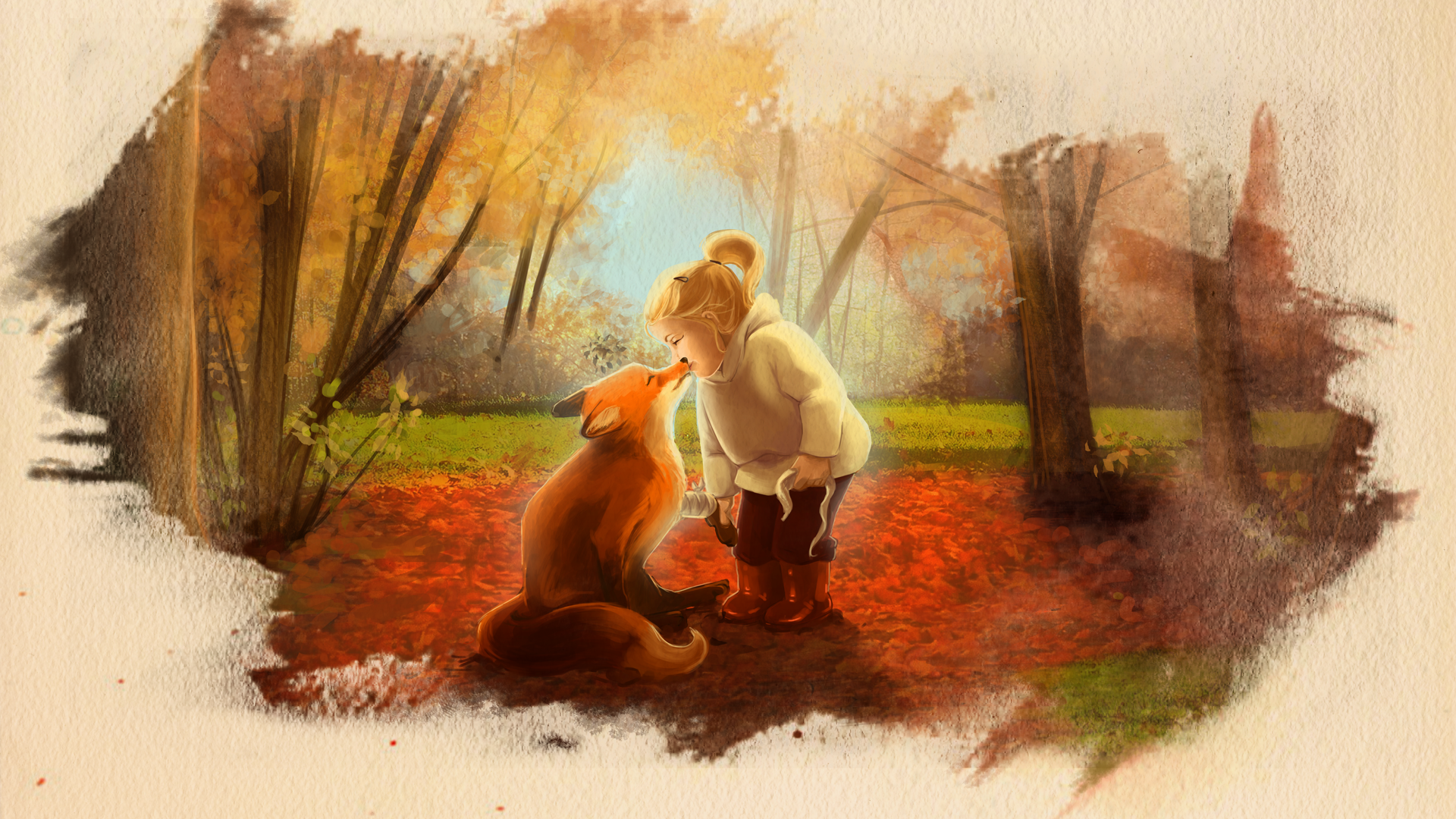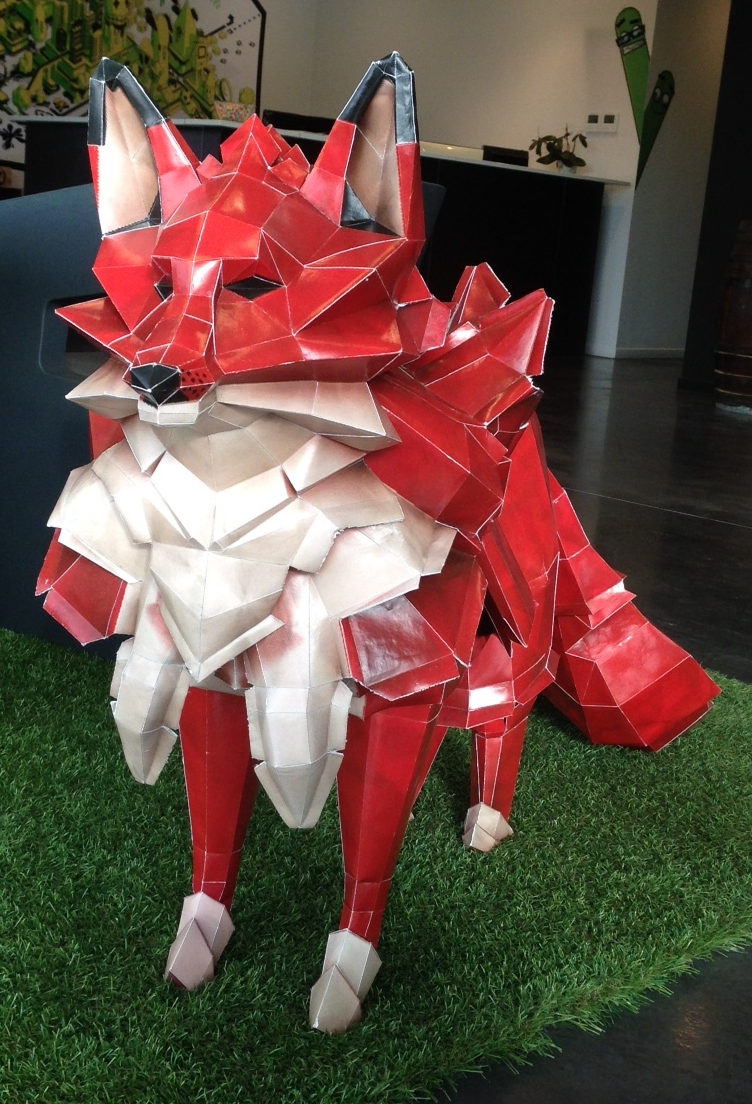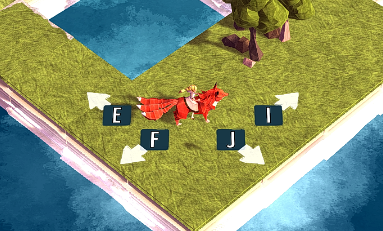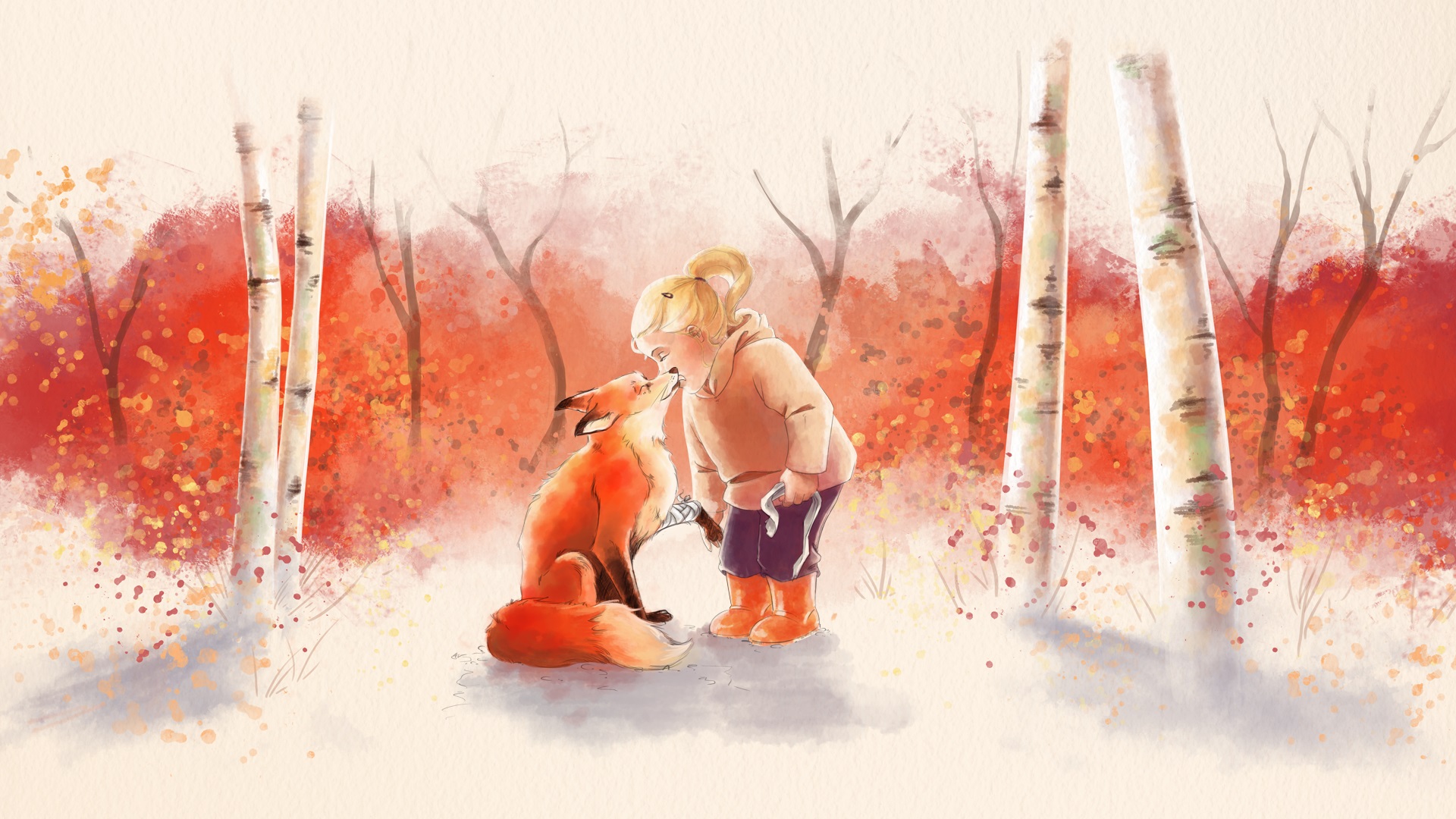[font=arial]Once upon a time[/font]
Epistory is a typing adventure game, built with Unity3D and released on March 30, 2016. It received very positive reviews - both from critics and players - and sold over 100k copies (including bundles). You can see the game's Steam page here. We recently opened a Discord channel for the company, which you can join using this link: discord.gg.
It's been one hell of a ride! In this retrospective article, we'll try to give you a sense of progression from the early prototypes up to the release of the game we all know and love. We'll also talk about the great endeavor a game like this represents, even though Epistory isn't a big game by AAA standards. We'll share some of our successes, failures and missed opportunities.
[font=arial]
 [/font]
[/font]
[font=arial]We tried several art styles for the collectible images. First try, not in the final game.[/font]
[font=arial]It was the best of times, it was the worst of times[/font]
The most critical thing to do in game development is to identify and remove the risks. You take the riskiest feature, and you try it as fast as possible because you don't want a nasty surprise when it's too late to make changes. With an adventure typing game, we didn't know how the typing mechanic would work out: so we created a playable prototype very early on. Our primary goals were to test a typing mechanic to interact with items, handle character movement (which was tile-based at the time), and the mixture of exploration, puzzles and arena fights.
Early game development is the best part because all opportunities are still open and you get to try a lot of interesting things. But it is also the worst part as most of what you try is not as interesting as expected. You experience optimism and doubt at the same time.
You can see our first working prototype yourself, but keep in mind that it is really barebone and that no artist was involved (it is made with the Construct 2 engine). After that point, development restarted from scratch, with a different engine (Unity 3D), but with all the experience we gathered from the prototype.
[font=arial]There was a girl[/font]
[font=arial]
When the prototyping phase ended, our next goal was to find a new take on the typing game genre, mostly focused on arcade gameplay for short game sessions. We were aiming for 18 short dungeons instead of the 8 large dungeons and overworld we currently have.[/font]
[font=arial]
Being a relatively small studio, we had to settle on the amount of money available for this adventure. At the beginning, our budget was around EUR125k. We'll explain later why and how but by the end, we were talking about EUR300k. That's 3 and a half people for a year and a half.[/font]
[font=arial]
 [/font]
[/font]
[font=arial]
Second attempt at an art style. Also not in the final game.[/font]
[font=arial]And she rode upon the back of a great fox[/font]
Since the first story ideas, we tried to link the typing mechanic with the process of writing a book. We started with a muse giving a writer's inspiration by typing words in a fantasy world which represented the writer's mind. As in the final game, at the beginning the world is empty and there is no story, so the project was called The Heroine of no Tale for quite some time. Mildly interesting fact: we got used to the acronym "THONT" and used it for a long time even after we named the game Epistory. Now the nickname is simply "Epi".
If you launched the prototype, you'll have noticed that the girl was walking and that there was no fox around. The great three-tailed fox is based on a mythical creature, a Japanese nine-tailed fox, which looked good in a papercraft style. But the real reason for its existence is that we needed to give the girl a mount, so that we could realistically increase movement speed without changing the world scale.
[font=arial]
 [/font]
[/font]
[font=arial]
We have a paper fox in the studio![/font]
[font=arial]But they were lost[/font]
At the start of the development, it was decided that Epistory would serve as an experiment for a new way to manage our projects. Instead of having one project manager serving as an overseer for the whole project, the whole team would be its own manager while one of the Fishing Cactus directors would act as a client/producer. At that time, there were only three developers in the team. One game designer, one programmer and one 3D artist. Each acted as the manager of the other two, responsible for updating the task list, validation of quality standard and so on.
Of course, when the project first started we didn't immediately see the implications of that kind of organization. After all, there's so much to do! Creating a list of tasks feels pointless when you don't even have a character moving in the game world. Over time, we organically divided the tasks usually dealt with by a project manager among ourselves. One of us would mostly handle the communication with the externs (localization and audio) while another would mostly deal with the task lists and keep an eye on the schedule and deadlines. In the last few months of development, the three of us would take a few hours to do a full update of the task list and the estimated time left, to make sure we were still on target budget-wise.
All in all, we think it worked OK. There's room for improvement, but as a first experiment, it could have been a train wreck!
[font=arial]They had always been lost[/font]
The first control system, inherited from the prototype, was tile-based and used DFJK to move. We grew tired of the way this worked: it was too slow, too clunky. We quickly changed over to navmesh-based movement, to unleash the player's freedom of movement. This was a lot better: we solved puzzles faster and had a better sense of exploration. But something kept nagging at us.
Why did we use DFJK to move instead of WASD like any other game? That's the question we got from everyone who tested the game at that point (and continued to hear even after release!). The answer is that we did not want the game to teach a bad typing behavior, because by playing you'll get used to typing that way. So we wanted to place the control keys on the middle row, where your fingers are supposed to rest on a typical typing position. But having cardinal direction controls aligned on a single row was very confusing.
So we began searching for more intuitive controls while maintaining good typing form. After repeated internal playtests of many weird control schemes (like 8 keys to handle 8 directions), we settled on EFJI (plus, after popular demand, we added WASD). This stays close to the default typing position and puts each diagonal direction to the corresponding key (that works more naturally because of our isometric-like view). That binding passed our ultimate "intuitivity" test: running in perfect circles without looking at the keyboard, which means that you can switch naturally between the eight possible directions.
[font=arial]
 [/font]
[/font]
[font=arial]
Final recommended movement keys[/font]
[font=arial]Until a path appeared[/font]
A few months after starting development, we saw more enthusiasm for the project's potential both inside the studio and among players. At first, we didn't know if there would be public demand for a typing game so we were really cautious. After showing the game a bit, we knew that we would be able to make something that players would be interested in. Besides that, the first independent game of Fishing Cactus has to be a critical success for the studio's image.
Our confidence was increasing and we decided to commit more resources to the project, considerably increasing its budget. What was supposed to be a small-ish arcade game was now going to feature a deeper story and have a bigger scope overall. The game was already in an advanced state: we had prepared a short demo for the upcoming Gamescom and we had the first hour or so of gameplay ready.
[font=arial]
 [/font]
[/font]
[font=arial]
We added a meteorite early to test some story ideas. We kept the effect, but the text changed a lot![/font]
We tried doing the story ourselves but it quickly became clear that, a) we were not gifted for that skill and b) we already had a lot of work just creating the game. We applied for pitches from writers for the game with story and structure intentions. We received a lot of answers: some of them were comical, some were a bit disturbing, but one struck us as the perfect match for the game.
The idea of a narrator looking for inspiration shifted to a deeper story: something personal, emotional, and introspective - something which can be read on different levels. We use different fonts and voices to give the player a few hints. You can read more about the story without spoilers.
With the story in place, we began searching for a voice. We needed someone who was capable of reaching the emotions needed for the story. Strangely enough, we received a lot of samples sounding like a radio commercial. Not bad by itself but so far from what we were looking for. Finally, we found her! Rachael Messer has a lot of experience voicing games and her voice was just right for Epistory. Her voiceover added a powerful dignity to the narration which really helps the story come to life.
[font=arial]And so she followed[/font]
The next big step was to rework the introduction of the game according to the new story direction and finish the first dungeon. The goal was to bring that first hour of the game to final quality, kind of like a large vertical slice.
Usually, a vertical slice (or VSD for vertical slice demo) is an early demo of the game that aims to show how the game could be at its best. It sets the target for the final visual quality and gameplay experience, but only for a small part of the game. Imagine that we take the final game and cut a thin slice of it; that's your vertical slice.
With one hour of gameplay at the middle of Epistory's development, we had the same objective as a vertical slice but with a larger chunk of the game. The other objective of polishing that part of the game was to get it ready for an early access release.
[font=arial]Was the path leading her?[/font]
And finally, that day came. We released Epistory in early access on September the 30th 2015 with the first chapter of the story (two of the eight dungeons). An early access release is like a mini-release: you feel the same joy and relief of leaving your game to the players, though it reaches a smaller audience than a full release. But the game is not finished so you come back the next day as if nothing had happened.
Well, actually not, because when you wake up the next day, you have received a lot of feedback for bugs and features. Mostly bugs. That means extra work for us to do - and quickly, because new players are seeing the game while you are working. It can be stressful, but that is valuable feedback we could never hope to get from internal playtests alone. So, thank you to all of you who took the time to write comments and send feedback.
That core group of early players also helps the game grow in popularity. And that is the other reason we released in early access: to build a community around the game before the actual launch. We get Steam reviews, shares on social networks, media coverage and word of mouth. When you are an indie and don't have a marketing budget that equals your development cost, it is what makes the difference between a commercial success or failure.
[font=arial]
 [/font]
[/font]
[font=arial]
Here's the third style for the images - the one that made it into the final game[/font]
[font=arial]Or was she leading it?[/font]
Naturally, we developed and added the rest of the game in the order of the story. The initial plan was to release it chapter by chapter throughout the early access, and we did that for the second chapter. But that method was taking us too much time to make temporary versions of the game, and we needed that time to make the game as polished as it could be. Since the updates were not really followed by more sells or visibility, we took the decision to wait and release the rest of the game in one batch.
While we are talking about the dungeons we can reveal some small anecdotes for each one.
As the first one to be made, Burning Hollow, has been the most reworked dungeon. From a linear beginner level, we restarted from scratch to add hidden treasures and backtracking. Forgotten Forest and Drowning Halls were more straightforward to design: the first one is focused on getting lost in a forest (more than what we could do in the overworld). The second is focused on solving puzzles. Ice Mausoleum has a lot of props which are modified versions of the ones in Burning Hollow as they are basically both underground caverns. One difference is that we added a bit of elevation on this one.
For the next half of the game, we were more experienced and we didn't want to make the same thing over and over. So we tried to make the dungeons look different, mostly by making them less flat. Creation City does exactly that: it has 7 stages and from the final fight at the top you can see everything behind. All items are sorted by stage and the stages above you are hidden so they do not block the camera. The more technically challenging was probably the Crystalline Mine because we added a new gameplay system with light switching. Setting all those lights and having the words hidden in the dark was way more complicated than we expected. Shattered Isles' design is inspired by the part in Forgotten Forest where you can see small islands floating under the level. Finally, Lost Desert has regular point of view of the mountain that symbolizes your final goal. The mountain you see there has additional parts that are hidden when you actually reach it.
[font=arial]She didn't know. It was just there[/font]
For eight years, we developed games for others and we used to keep our games secret until the publisher decided to release it. So, our first question was: when should we make the game public? Having the choice of going public early in development was quite shiny and new and definitely what we wanted. But the real question was: what did the game need?
Releasing a typing game as your first product is a big challenge. We knew from the beginning that Epistory was going to be a fairly niche game. Too often categorized as an educational game, we tried to emphasize on the art style and the "RPG - Adventure - Puzzle" side of it and after early feedback from the community, we came up with a tagline: "If Zelda and a keyboard had a baby, it would be Epistory."
We didn't like to explain our game solely by comparing it to others, but with such a nebulous concept, it felt like a necessity.
Our whole team got involved with public communications, which was definitely an advantage to us. It saved us time and helped present a better image of ourselves. It helped with community management, both during events and when we needed to write articles about development. The idea was to try our best to give a real, honest insight into development to people who followed the project. We will publish an article diving deeper into our communication strategy soon.
[font=arial]
 [/font]
[/font]
[font=arial]
One of our marketing images.[/font]
[font=arial]All of a sudden, she knew where she was[/font]
Throughout early access, we were careful to always be present, active and helpful in the Steam forums. We were (and still are) firm believers in direct communication between players and the development team. It creates a strong community and we even received praise just for being there. It's also great to get to interact with streamers and YouTubers, mostly as a surprise random encounter in the video's comments or the chat.
Since we don't have the resources to organize extensive playtests, checking Let's Plays was a major source for bug hunting and player behavior analysis. Our tutorial messages were updated to be clearer after seeing videos with players not fully understanding the fire magic burning effect. Thanks, by the way, to any streams and LPers who gave us this excellent feedback!
By February 2016, after releasing two chapters on early access, most of the game was ready. The finishing touches were being added to the last dungeon of the game. The ending sequence and the accompanying video were being finalized. The list of bugs was shrinking day by day as we polished the game, getting it ready for its big day.
[font=arial]She was home[/font]
Fast forward a few weeks and: Launch Day!
The game has been polished until it shines like a mirror. After several months of prototyping, followed by a year and a half of production, we were finally ready to hit the big green LAUNCH button.
In the days that followed, we were ecstatic. The players loved the game, the critics loved the game, we loved the game and we were -and still are- proud of our achievement.
But this was only the first part of the journey. To this day, one year after that release, Epistory is still being worked on albeit at a slow pace. We can't wait to share our next projects with the community.
[font=arial]


